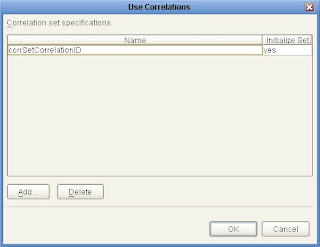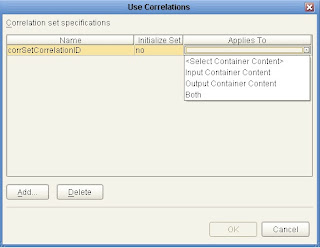The portion of my business process which requires correlation involves calling out to a notification web service and supplying an unbounded set of people to which I want to notify. This notification web service then responds with a single notification identifier (notification ID) representing the notification sent. At some future point in time, the people notified will respond (or the notification system will let me know there was no response). These responses can be received in any order at any time, and are received via a web service call into my ESB. The payload of this web service call includes the notification ID and the response of the person. After receiving the response, my business process updates the person information with the response and continues on. This is exactly what correlations are made for. Perfect!
Challenge 1: If I define correlation initialization on the notification web service invocation activity, this will persist 1 instance of the business process. But I have multiple responses coming back. After the first response is received, I have no business process instances waiting.
Solution 1a: I'll just loop around the web service invocation for each person in my set of people and make individual calls out to the notification web service. This will create multiple notification IDs and therefore persist multiple business process instances. So as responses come back, each one will correspond to its own instance. The business process would look something like this:
 Problems: First, the business process will always run to completion as the response web service implementation gets invoked after the while loop (i.e. there is no receive task for the process to wait on). So, if we replace the web service implementation with a JMS receive task we can get over that hurdle. All we have to do is create another business process that implements a web service, and within the implementation it uses a JMS send activity to send the notification response to the corresponding JMS queue that this process is monitoring. The new business processes look like this:
Problems: First, the business process will always run to completion as the response web service implementation gets invoked after the while loop (i.e. there is no receive task for the process to wait on). So, if we replace the web service implementation with a JMS receive task we can get over that hurdle. All we have to do is create another business process that implements a web service, and within the implementation it uses a JMS send activity to send the notification response to the corresponding JMS queue that this process is monitoring. The new business processes look like this:
 Now the problem is that we really only have one business process instance being created. Although it seems like multiple business process instances are being persisted, each one really maps to the same instance. So, once the 1st response is received, the persisted instance is gone and other responses are left hanging.
Now the problem is that we really only have one business process instance being created. Although it seems like multiple business process instances are being persisted, each one really maps to the same instance. So, once the 1st response is received, the persisted instance is gone and other responses are left hanging.Solution 1b: So, we remove the loop here and will need to create another business process (we are now up to 3 business processes) that sends messages with a single person to the inbound JMS queue. This will cause a new business process instance to be created for each person, so each response can now be correlated to one of these instances.
Challenge 2: How do we define the correlation set so that it actually works? Our correlation aliases were initially defined as the notification ID returning from the notification web service invocation and the JMS receive message text. Since the message text value (an XML message) does not match the notification ID (an int data type), the correlation is not working.
Solution: This was a difficult one. I went through many iterations with problems....err challenges encountered with each one. Here they are:
(1) Add an unmarshal task so that we can correlate on the resulting notification ID value. This will require using correlation on the Unmarshal activity. Since the JMS receive activity, which occurs prior to the unmarshal, causes the BPEL engine to retrieve an instance from persistence, and no correlation set is defined for this task, the engine grabs any instance. So essentially there is no real correlation going on.
(2) Try using the JMS message header correlation ID. This involved mapping the response notification ID to the correlation ID of the JMS message header prior to placing this on the response queue (in our second business process). The issue here was the correlation ID message property is defined as a string, while the notification ID is an int. So CAPS will not let you define an appropriate correlation key/correlation set that will work. The data types of each alias need to be the same, which makes sense. Also, since my business process has 2 JMS receive tasks, the BPEL engine gets confused when trying to create the instance identifier using the correlation ID of the JMS message header.
(3) Call for help. I discussed this problem with someone I know from Sun and he was able to provide a pre-release of some documentation that provided a good amount of insight into how to deal with correlations. The result of this new found knowledge was the creation of one more business process (for a total of 4) that actually had 2 JMS receive tasks. I could then create a correlation set based on the JMS message header correlationID and use correlations on each of the JMS receive tasks. The following images show 3 of the 4 business processes (the one not shown is simply a loop that places messages on the inbound JMS queue for the notification web service invocation process).
Notification Web Service Invocation

First, a message is placed on the inbound queue of the notification web service invocation process. This calls the external web service and uses the response to place a message on the correlation.queue JMS queue. Also, the notification ID that is the response from the web service invocation is set to the JMS message header correlationID property.
Recall that the Combined Business Process has a correlation set defined to be the correlationID message header property. The 2 JMS receive activities are set to use correlations. The first receive task initializes it and the second uses it.
So, once the first message is received, an instance of the Combine Business Process is created and then persisted (since it is now waiting on the second JMS receive). Now, at some future point in time, a person responds to the notification (or the service responds with "no response"). The response includes the notification ID and the response. The Notification Response Web Service Implementation maps the notification ID to the correlationID message property and places the response on the response.queue.
The second JMS receive task on the Combined Business Process is using this queue. This causes the BPEL engine to retrieve the business process instance that corresponds to the notification ID contained within the persons response. The process instance is retrieved (along with its state), and the business process continues to completion. This implementation of correlation finally worked.
From initial design to final implementation took longer (and was more painful) than it sounds. As a result I got a great understanding of how correlation works within CAPS and I am confident that this knowledge will transfer to other products as well.









